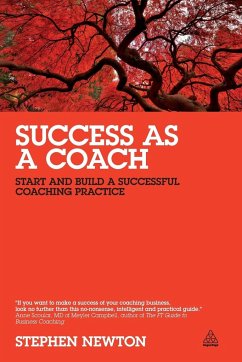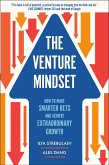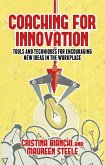- Broschiertes Buch
- Merkliste
- Auf die Merkliste
- Bewerten Bewerten
- Teilen
- Produkt teilen
- Produkterinnerung
- Produkterinnerung
What does it take to be a successful coach? Assuming that you already possess the right skills, characteristics and training then success simply lies in finding and winning clients that you can coach successfully. Personal fulfilment and profitable fee revenue will be direct results. Unfortunately this isn't as simple as it might seem. Success as a Coach is your complete guide to business development whether you're newly qualified or an experienced coach. It covers all the crucial factors that will help you build your clients and your business including: finding the right clients; extending…mehr
Andere Kunden interessierten sich auch für
![Winning Winning]() Jack WelchWinning8,00 €
Jack WelchWinning8,00 €![Don't Buy This Book Don't Buy This Book]() Bruijn, Anne, deDon't Buy This Book24,99 €
Bruijn, Anne, deDon't Buy This Book24,99 €![Winning Winning]() Jack WelchWinning18,99 €
Jack WelchWinning18,99 €![Winning Winning]() Jack WelchWinning14,99 €
Jack WelchWinning14,99 €![The Venture Mindset The Venture Mindset]() Ilya StrebulaevThe Venture Mindset25,99 €
Ilya StrebulaevThe Venture Mindset25,99 €![Coaching for Innovation Coaching for Innovation]() Cristina BianchiCoaching for Innovation38,99 €
Cristina BianchiCoaching for Innovation38,99 €![Transformative Entrepreneurs Transformative Entrepreneurs]() Jeffrey A. HarrisTransformative Entrepreneurs34,99 €
Jeffrey A. HarrisTransformative Entrepreneurs34,99 €-
-
-
What does it take to be a successful coach? Assuming that you already possess the right skills, characteristics and training then success simply lies in finding and winning clients that you can coach successfully. Personal fulfilment and profitable fee revenue will be direct results. Unfortunately this isn't as simple as it might seem. Success as a Coach is your complete guide to business development whether you're newly qualified or an experienced coach. It covers all the crucial factors that will help you build your clients and your business including: finding the right clients; extending your professional network; planning and running meetings; delivering value for the client; calculating fees; structuring and delivering sessions; structuring your business; strategic client leadership and systematically growing your business. Additional downloadable tools and templates will be available from www.successasacoach.com on publication.
Produktdetails
- Produktdetails
- Verlag: Kogan Page
- Seitenzahl: 280
- Erscheinungstermin: 29. Oktober 2013
- Englisch
- Abmessung: 234mm x 156mm x 15mm
- Gewicht: 433g
- ISBN-13: 9780749469092
- ISBN-10: 0749469099
- Artikelnr.: 37664745
- Herstellerkennzeichnung
- Libri GmbH
- Europaallee 1
- 36244 Bad Hersfeld
- gpsr@libri.de
- Verlag: Kogan Page
- Seitenzahl: 280
- Erscheinungstermin: 29. Oktober 2013
- Englisch
- Abmessung: 234mm x 156mm x 15mm
- Gewicht: 433g
- ISBN-13: 9780749469092
- ISBN-10: 0749469099
- Artikelnr.: 37664745
- Herstellerkennzeichnung
- Libri GmbH
- Europaallee 1
- 36244 Bad Hersfeld
- gpsr@libri.de
Stephen Newton has worked as a business coach and consultant since 2001, when he established his business, DLO Associates. He enables clients to implement effective strategy and enhance bottom line results. His focus is leadership development, operational management, and communication. He is currently working with Meyler Campbell, a business coach training organization which runs a Business Development Bootcamp. He is also the author of The Professionals Guide to Business Development, published by Kogan Page. For more information visit www.successasacoach.com.
Introduction
01 The business of coaching: an overview
The coaching industry
Some industry data...
How many coaches?
Use of coaching
Fees and workload
What do we mean by 'coaching'?
Who buys coaching?
Coach matching/broking services
Coach selection processes and certifi cation
Factors that infl uence the buying process
How do coaching businesses operate?
How is coaching carried out?
How much money do coaches make?
The business case for coaching
References
02 Identifying the right clients
Coaching or a coach?
The importance of positioning
What makes the client 'right'?
Identifying the right client
What does 'good' look like for you?
Your skills and experience
What benefi ts do you uniquely deliver?
Linking your USP to the perfect client
Positioning yourself as an expert
03 Marketing collateral
Your website
Your domain name
Web hosting
Building your website
Designing your website
Content: keeping it simple
Other marketing collateral
Written material
The use of video
Speaking engagements
Taster sessions and consultations
04 Connecting with the right clients
Extending your professional network and winning referrals
Before we begin...
Constructive visibility
Your target audience: narrowing your field of play
How and where to find good clients for you
A giving agenda
Offline network development
Online network building
Referrals
05 Meetings: how to plan and run them for success
Perceptions you generate
Meeting mind-set: being yourself
Gaze aversion in conversation
PowerPoint
Conversation is the new PowerPoint
Ensuring success in meetings
Planning each meeting
Pre-meeting communication
At the start of the meeting
Gathering information
Next steps
06 Value in the eyes of the client
What does 'value' mean?
Budget appetite
Self-worth and confidence
Building your value equations
Articulating the value you deliver
Handling competition
07 Fees: how to be paid what you are worth
A reality check
A 'typical' working week
Fee structures
Actual fee levels
Engagement structures
Charging for expenses
Group sessions
'Remote' coaching
Terms and conditions
Payment terms
The relationship pyramid
08 Structuring and delivering a successful coaching engagement
The chemistry meeting
Writing proposals (or letters of confirmation)
Goal setting
Session duration and frequency
Time-keeping in sessions
Listening and the use of silence
Note taking
Action points/next steps
The end of an engagement
Pulling the plug
09 Structuring your business
The legal structure of your business
Insurances and consents
Physical location versus postal address
Business models
Recruiting partners or associates
Accreditation and certification
The infrastructure of your business
Physical office space
Time allocation
10 Strategic client leadership
Why can SCL be important for your business?
SCL is not for everyone...
The relationship factor
Where are you on the pyramid?
How to move to SCL?
11 Systems set your business free
Why systems?
Design from the end backwards
The statement of strategic aims: what is my business?
Business operating principles
Standard operating procedures
Core systems
Time allocation
In conclusion
01 The business of coaching: an overview
The coaching industry
Some industry data...
How many coaches?
Use of coaching
Fees and workload
What do we mean by 'coaching'?
Who buys coaching?
Coach matching/broking services
Coach selection processes and certifi cation
Factors that infl uence the buying process
How do coaching businesses operate?
How is coaching carried out?
How much money do coaches make?
The business case for coaching
References
02 Identifying the right clients
Coaching or a coach?
The importance of positioning
What makes the client 'right'?
Identifying the right client
What does 'good' look like for you?
Your skills and experience
What benefi ts do you uniquely deliver?
Linking your USP to the perfect client
Positioning yourself as an expert
03 Marketing collateral
Your website
Your domain name
Web hosting
Building your website
Designing your website
Content: keeping it simple
Other marketing collateral
Written material
The use of video
Speaking engagements
Taster sessions and consultations
04 Connecting with the right clients
Extending your professional network and winning referrals
Before we begin...
Constructive visibility
Your target audience: narrowing your field of play
How and where to find good clients for you
A giving agenda
Offline network development
Online network building
Referrals
05 Meetings: how to plan and run them for success
Perceptions you generate
Meeting mind-set: being yourself
Gaze aversion in conversation
PowerPoint
Conversation is the new PowerPoint
Ensuring success in meetings
Planning each meeting
Pre-meeting communication
At the start of the meeting
Gathering information
Next steps
06 Value in the eyes of the client
What does 'value' mean?
Budget appetite
Self-worth and confidence
Building your value equations
Articulating the value you deliver
Handling competition
07 Fees: how to be paid what you are worth
A reality check
A 'typical' working week
Fee structures
Actual fee levels
Engagement structures
Charging for expenses
Group sessions
'Remote' coaching
Terms and conditions
Payment terms
The relationship pyramid
08 Structuring and delivering a successful coaching engagement
The chemistry meeting
Writing proposals (or letters of confirmation)
Goal setting
Session duration and frequency
Time-keeping in sessions
Listening and the use of silence
Note taking
Action points/next steps
The end of an engagement
Pulling the plug
09 Structuring your business
The legal structure of your business
Insurances and consents
Physical location versus postal address
Business models
Recruiting partners or associates
Accreditation and certification
The infrastructure of your business
Physical office space
Time allocation
10 Strategic client leadership
Why can SCL be important for your business?
SCL is not for everyone...
The relationship factor
Where are you on the pyramid?
How to move to SCL?
11 Systems set your business free
Why systems?
Design from the end backwards
The statement of strategic aims: what is my business?
Business operating principles
Standard operating procedures
Core systems
Time allocation
In conclusion
Introduction
01 The business of coaching: an overview
The coaching industry
Some industry data...
How many coaches?
Use of coaching
Fees and workload
What do we mean by 'coaching'?
Who buys coaching?
Coach matching/broking services
Coach selection processes and certifi cation
Factors that infl uence the buying process
How do coaching businesses operate?
How is coaching carried out?
How much money do coaches make?
The business case for coaching
References
02 Identifying the right clients
Coaching or a coach?
The importance of positioning
What makes the client 'right'?
Identifying the right client
What does 'good' look like for you?
Your skills and experience
What benefi ts do you uniquely deliver?
Linking your USP to the perfect client
Positioning yourself as an expert
03 Marketing collateral
Your website
Your domain name
Web hosting
Building your website
Designing your website
Content: keeping it simple
Other marketing collateral
Written material
The use of video
Speaking engagements
Taster sessions and consultations
04 Connecting with the right clients
Extending your professional network and winning referrals
Before we begin...
Constructive visibility
Your target audience: narrowing your field of play
How and where to find good clients for you
A giving agenda
Offline network development
Online network building
Referrals
05 Meetings: how to plan and run them for success
Perceptions you generate
Meeting mind-set: being yourself
Gaze aversion in conversation
PowerPoint
Conversation is the new PowerPoint
Ensuring success in meetings
Planning each meeting
Pre-meeting communication
At the start of the meeting
Gathering information
Next steps
06 Value in the eyes of the client
What does 'value' mean?
Budget appetite
Self-worth and confidence
Building your value equations
Articulating the value you deliver
Handling competition
07 Fees: how to be paid what you are worth
A reality check
A 'typical' working week
Fee structures
Actual fee levels
Engagement structures
Charging for expenses
Group sessions
'Remote' coaching
Terms and conditions
Payment terms
The relationship pyramid
08 Structuring and delivering a successful coaching engagement
The chemistry meeting
Writing proposals (or letters of confirmation)
Goal setting
Session duration and frequency
Time-keeping in sessions
Listening and the use of silence
Note taking
Action points/next steps
The end of an engagement
Pulling the plug
09 Structuring your business
The legal structure of your business
Insurances and consents
Physical location versus postal address
Business models
Recruiting partners or associates
Accreditation and certification
The infrastructure of your business
Physical office space
Time allocation
10 Strategic client leadership
Why can SCL be important for your business?
SCL is not for everyone...
The relationship factor
Where are you on the pyramid?
How to move to SCL?
11 Systems set your business free
Why systems?
Design from the end backwards
The statement of strategic aims: what is my business?
Business operating principles
Standard operating procedures
Core systems
Time allocation
In conclusion
01 The business of coaching: an overview
The coaching industry
Some industry data...
How many coaches?
Use of coaching
Fees and workload
What do we mean by 'coaching'?
Who buys coaching?
Coach matching/broking services
Coach selection processes and certifi cation
Factors that infl uence the buying process
How do coaching businesses operate?
How is coaching carried out?
How much money do coaches make?
The business case for coaching
References
02 Identifying the right clients
Coaching or a coach?
The importance of positioning
What makes the client 'right'?
Identifying the right client
What does 'good' look like for you?
Your skills and experience
What benefi ts do you uniquely deliver?
Linking your USP to the perfect client
Positioning yourself as an expert
03 Marketing collateral
Your website
Your domain name
Web hosting
Building your website
Designing your website
Content: keeping it simple
Other marketing collateral
Written material
The use of video
Speaking engagements
Taster sessions and consultations
04 Connecting with the right clients
Extending your professional network and winning referrals
Before we begin...
Constructive visibility
Your target audience: narrowing your field of play
How and where to find good clients for you
A giving agenda
Offline network development
Online network building
Referrals
05 Meetings: how to plan and run them for success
Perceptions you generate
Meeting mind-set: being yourself
Gaze aversion in conversation
PowerPoint
Conversation is the new PowerPoint
Ensuring success in meetings
Planning each meeting
Pre-meeting communication
At the start of the meeting
Gathering information
Next steps
06 Value in the eyes of the client
What does 'value' mean?
Budget appetite
Self-worth and confidence
Building your value equations
Articulating the value you deliver
Handling competition
07 Fees: how to be paid what you are worth
A reality check
A 'typical' working week
Fee structures
Actual fee levels
Engagement structures
Charging for expenses
Group sessions
'Remote' coaching
Terms and conditions
Payment terms
The relationship pyramid
08 Structuring and delivering a successful coaching engagement
The chemistry meeting
Writing proposals (or letters of confirmation)
Goal setting
Session duration and frequency
Time-keeping in sessions
Listening and the use of silence
Note taking
Action points/next steps
The end of an engagement
Pulling the plug
09 Structuring your business
The legal structure of your business
Insurances and consents
Physical location versus postal address
Business models
Recruiting partners or associates
Accreditation and certification
The infrastructure of your business
Physical office space
Time allocation
10 Strategic client leadership
Why can SCL be important for your business?
SCL is not for everyone...
The relationship factor
Where are you on the pyramid?
How to move to SCL?
11 Systems set your business free
Why systems?
Design from the end backwards
The statement of strategic aims: what is my business?
Business operating principles
Standard operating procedures
Core systems
Time allocation
In conclusion








